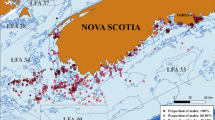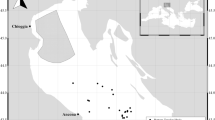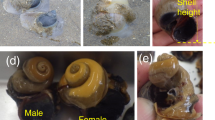Abstract
Monitoring the moulting phenology of American lobsters (Homarus americanus) is important for maintaining sustainable lobster stocks. Changes in lobster landings can affect reproduction and disease susceptibility. Data on lobster moult indicators and on life-history traits (sex, size) were collated from a twelve-year monitoring program (2004–2015) in six lobster fishing areas in Atlantic Canada. A total of 141,659 lobsters were sampled over 1,195 sampling events using a standardized protocol and commercial lobster fishing traps. The dataset contains pleopod stages, estimated hemolymph protein levels (°Brix values) and shell hardness as well as lobster sex and size. Evaluation of sex ratio dynamics is also possible but existing biases in sampling males and females needs to be noted. This dataset is valuable in terms of inferring spatio-temporal trends in the life history of lobsters, as well as in the analysis of their moult cycle, and hence more generally for fisheries science and marine ecology.
Measurement(s) | Lobster sex • Lobster size • Lobster moult stage • °Brix value of hemolymph • Lobster shell hardness |
Technology Type(s) | Eye • Vernier Caliper • Microscopic assessemnt of pleopods • Refractometer • Physical assessment of lobster carapace |
Factor Type(s) | Year • Month • Lobster fishing area (LFA) • Location • Sampling event • Water depth |
Sample Characteristic - Organism | Homarus americanus |
Sample Characteristic - Environment | marine water body |
Sample Characteristic - Location | Northwest Atlantic Ocean coastal waters of Canada |
Similar content being viewed by others
Background & Summary
Increased landings of soft-shelled lobsters in southwestern Nova Scotia in the last 20 years has been a concern to the Canadian lobster industry1,2. Soft-shelled lobsters are considered lower quality because they have a lower meat yield and fare poorly during transportation and holding. American lobsters are the most valuable fisheries product in Atlantic Canada, generating $1.6B CAD out of the total of $3.2B CAD for all fisheries landings in this region in 20193. Consequently, monitoring lobster shell quality and population dynamics is of great economic importance for local fisheries.
The range of the American lobster, Homarus Americanus, extends from North Carolina (USA) to the coasts of southern Newfoundland and Labrador (Canada)4. Lobsters moult repeatedly during their life cycle4. Moulting is divided into four main stages: intermoult, the time between two moults; premoult, where the new shell is formed and and body size swells temporarily through water absorption; the actual moult, when the old shell is repelled; and the postmoult period, when the new shell calcifies5. The premoult stage is further divided into ten substages inferred from changes in the pleopod appendages6. In the first year of growth, individual lobsters may moult up to ten times, and as size increases, moulting frequency decreases (Cobb 1976). Large individuals may only moult every other year4. Males tend to moult earlier than females in the breeding season (Cowan and Atema 1990) and female lobsters usually mate after moulting when their shell is still soft (Atema et al. 1979). Females do not usually moult while carrying eggs7.
As for all ectotherms, temperature affects most physiological processes in lobsters, including moulting2. Previous studies have reported that warmer temperatures lead to an earlier spring moult in lobsters in the Gulf of Maine (USA)8. A change in the timing of peak moulting could therefore change the proportion of postmoult lobsters in fisheries catches. These still have a soft shell and are vulnerable to intraspecific competition. In this stage, new tissue slowly replaces the water that was taken up during postmoult9. Accordingly, soft-shelled lobsters have lower protein levels and meat yields compared to intermoult lobsters which can have commercial implications for the fishery2.
To monitor changes in the moult cycle and shell quality of American lobsters in Atlantic Canada, the Atlantic Veterinary College Lobster Science Centre (Charlottetown, PE) implemented the Atlantic Lobster Moult and Quality Project in 2004. The Fishermen and Scientists Research Society contributed to the regular lobster samplings in Nova Scotia until 20142. Here we present data on moult stage, shell hardness, estimated hemolymph protein levels, lobster sex, and size that were collected by trap hauls during and outside of the commercial fishing season. The dataset includes changes in lobster characteristics over twelve years and over six different lobster fishing areas. Previous research on this dataset has already identified risk factors for soft-shelled lobsters in Atlantic Canada1.
Methods
Data collection
The present dataset was collected within the framework of the Atlantic Lobster Moult and Quality (ALMQ) project originally managed and implemented by the Atlantic Veterinary College Lobster Science Centre at the University of Prince Edward Island in collaboration with the Fishermen and Scientists Research Society. The Atlantic Lobster Moult and Quality project was initially funded through the Atlantic Innovation Fund program from the Atlantic Canada Opportunities Agency (ACOA) and transferred to the Fishermen and Scientists Research Society (FSRS) in 2012.
Sampling took place every 2–3 weeks in eight lobster fishing areas (LFA) in Atlantic Canada from 2004 to 2014 (see Fig. 1, Table 1). The sampling followed the FSRS Lobster Moult and Quality sampling protocol and was conducted by technicians from the Atlantic Veterinary College and the Fishermen and Scientists Research Society in fixed locations from traps set the day before2. Locations based on targeted sampling (LFA 33 and 34) were chosen according to the fishing efforts in the respective areas and selected by a lobster science committee consisting of members from industry, academia, research and federal and provincial representatives. Other locations (LFA 24, 25, 26A, 35) were chosen based on proximity to the Atlantic Veterinary College and other projects with commercial fishers which allowed sampling.
(a) Map of the lobster fishing areas (LFAs) in the Maritime Provinces in eastern Canada with the sampling locations (red) recorded by the AVC Lobster Science Centre for the Atlantic Lobster Moult and Quality project. (b) Enlarged map of LFA 33. (c) Enlarged map of LFAs on Prince Edward Island. The maps were created using QGIS (v. 3.18; https://qgis.org). Contours depict water depths in meters.
For each sampling event, 40 commercial lobster traps with escape vents for lobsters below the minimum legal size were used. Legal sizes depend on size-at-maturity (size at which 50% of the population reach maturity) which differs between LFAs due to regional differences in water temperature that influence lobster growth. There were some differences in sampling procedure between lobster fishing season and off-season. During lobster fishing season sampling took place within 48 h post landing and only legal-sized lobsters were assessed. During off season, lobsters were sampled directly on board chartered boats and were returned to sea immediately after sampling. During non-fishing season sampling, lobsters below minimum legal size were also sampled but no egg-bearing females were targeted to minimize negative handling effects. Targeted sample size was 200 lobsters per sampling event before 2009 and 125 lobsters after 2009 due to budget constraints.
On average, 3–4 lobsters of each sex were sampled in every 2 mm lobster size grouping. Lobster size was recorded as the carapace length in mm and determined using calipers rounding down to the nearest mm. The size distribution of sampled lobsters is presented in Fig. 2. Lobsters were assessed for general health (lesions, shell damage, liveliness/vigour) and shell hardness. Shell hardness was recorded as soft, medium or hard. A carapace of a soft-shelled lobster would be compressible at the ventral and dorsal (anterior and posterior) carapace, a medium-shelled lobster would only be compressible at the ventral carapace and a hard-shelled lobster would not be compressible at any carapace location.
To estimate hemolymph protein levels, the ventral abdomen between the first pair of walking legs was sprayed with 70% ethanol and 3 ml of hemolymph were extracted with a 22 gauge needle and a 3 ml syringe. A few drops of hemolymph were placed on a handheld refractometer and the refractive index (“°Brix” value) was recorded and used as a proxy for total hemolymph levels. The distribution of hemolymph protein level is shown in Fig. 3. The moult stages were determined by pleopod stages under a stereomicroscope and recorded in pleopod stages (see Table 2). The stage determinations are shown in Table 2 and Fig. 46.
Pleopod stages of lobsters at different times in their moult cycle. Illustrations by Lavallée et al.2.
In total, 141,659 lobsters were sampled from 2004–2015 over 1,195 sampling events. Data were recorded manually on data sheets and re-checked before being entered into an Excel data sheet (Excel, Microsoft).
Data Records
The data fields are described in Table 3. The data represent moult stage and shell quality of each sampled lobster together with additional data on lobster characteristics (sex, size) and spatial-temporal information over the 12-year sampling period. The table consists of 141,659 rows and 15 columns and each row represents one sampled lobster. To ensure uniqueness of the records, the associated information for each sampling event is reported as several lobsters were sampled per sampling event. Summary statistics for continuous and categorical variables are presented in Tables 4 and 5. Data are published on the data depository Zenodo (https://doi.org/10.5281/zenodo.6588031)10.
Technical Validation
A standardized sampling protocol was followed over the whole study period to avoid bias due to the fact that sampling was conducted by a variety of staff. In 2009, the sampling size changed from approximately 200 lobsters per sampling event to 125 due to budget constraints.
The dataset was validated by repeated data quality checks at time of sampling and sample processing. In the former, errors were corrected where appropriate. In the latter, diagnostic plots and tables were checked and outliers were identified by the 1.5 interquartile rule (Figs. 2, 3). If outliers were out of the biological range, they were then treated as data entry errors and classified as missing values (“NA”). Location data were validated by checking the sampling locations in Google Maps to ensure correct matching with the associated LFA data.
Usage Notes
With more than 140,000 observations, our dataset provides valuable information on moult indicators and other lobster characteristics in regions that are of high commercial value for lobster fisheries. It is important to note that the trap-based design of the survey may not represent the true natural lobster population unless an approach to adjust for sampling bias is accounted for. For example, lobsters that are close to or have just moulted are shelter seeking and would likely not encounter traps. It was not feasible to sample all locations consistently at the same time resulting in some locations being less represented than others. This could be a limiting factor for future analyses.
Data transformation and Gaussian curve fitting can be implemented to estimate peak moulting time and compare it across years and within locations. While the estimation of hemolymph protein levels and pleopod staging are objective, the shell hardness assessment is subjective methods as it was carried out by manual squeezing of the lobster carapace. This should be considered when using these variables as moult indicators during analysis.
Caution should be taken when analysing sex ratio patterns with these data as the sampling protocol targeted an equal number of males and females per sampling. However, a 50:50 sex ratio was recorded in only 21 of the 1,195 sampling events. This indicates that trends in sex ratio patterns could be inferred from this dataset. The fact that either not enough males or females were present in the traps to reach equal sampling frequency could indicate skewed sex ratios in the lobster population, temporal shelter-restricted behaviour differences between gender, or reluctance for one gender to enter a trap if larger lobsters of the other gender are already present. This could be further analysed by mixed effect linear regression models.
A limitation of this dataset is that temperature data are missing for sampling events and thus for the individual observations. It is possible to obtain satellite based retrospective sea surface temperature data from databases such as NOAA (National Oceanic and Atmospheric Administration)11 or NASA (NASA Earth Observatory)12 for these fishing areas, which have been used in previous scientific explorations of this dataset1. As sea surface temperatures may not be as useful as bottom temperatures for benthic species, the latter could be obtained retrospectively from ocean models from websites such as HYCOM (Hybrid Coordinate Ocean Model)13.
Data are provided in a CSV format. Care must be taken with conversion of columns containing DD/MM/YYYY data from CSV files. Therefore, sampling year and sampling month are provided as separate fields.
Code availability
There was no custom R code produced during the collation and validation of this dataset.
References
Thakur, K. K. et al. Risk factors associated with soft-shelled lobsters (Homarus americanus) in southwestern Nova Scotia. Canada. FACETS 2, 15–33 (2017).
Lavallée, J. et al. Atlantic Lobster Moult and Quality Project. Final Report. (2013).
DFO. Seafisheries landings. https://www.dfo-mpo.gc.ca/stats/commercial/sea-maritimes-eng.htm (2021).
Lawton, P. & Lavalli, K. Postlarval, juvenile, adolescent and adult ecology. in Biology of the lobster Homarus americanus (ed. JD, F.) 47–81 (Academic, 1995).
Aiken, D. E. Molting and Growth. in The Biology and Management of Lobsters Vol. 1 91–163 (Academic Press, 1980).
Aiken, D. E. Proecdysis, setal development, and molt prediction in the American Lobster (Homarus americanus). J. Fish. Res. Board Canada 30, 1337–1344 (1973).
Talbot, P. & Helluy, S. Reproduction and embryonic development. in Biology of the Lobster 177–216, https://doi.org/10.1016/b978-012247570-2/50031-1 (Academic Press, 1995).
Groner, M. L., Shields, J. D., Landers, D. F., Swenarton, J. & Hoenig, J. M. Rising temperatures, molting phenology, and epizootic shell disease in the American lobster. Am. Nat. 192, 163–177 (2018).
Wang, G. & Mcgaw, I. J. Use of serum protein concentration as an indicator of quality and physiological condition in the lobster Homarus americanus (Milne-Edwards, 1837). J. Shellfish Res. 33, 805–813 (2014).
Koepper, S., Scott-Tibbetts, S., Lavallée, J., Revie, C. W. & Thakur, K. K. Fisheries dataset on moulting patterns and shell quality of American lobsters H.americanus in Atlantic Canada. Zenodo https://doi.org/10.5281/zenodo.6320314 (2022).
NOAA. NOAA Office of Satellite and Product Operations. https://www.ospo.noaa.gov/Products/ocean/sst/contour/ (2022).
NASA. NASA Earth Observatory. https://earthobservatory.nasa.gov/ (2022).
HYCOM. Hybrid Coordiante Ocean Model. https://www.hycom.org/ (2022).
Acknowledgements
We would like to acknowledge the contributions of all professional and technical staff to make the field sampling possible. We also thank the ALMQ steering committee for support and contribution to the study design. Many thanks also to the industry partners without whose help and dedication the collection of these data would not have been possible. Funding was provided by Fisheries and Oceans Canada, the Province of Nova Scotia, First Nations, the Fishermen & Scientists Research Societyand the Atlantic Canada Opportunities Agency under the Atlantic Innovation Fund.
Author information
Authors and Affiliations
Contributions
J.L. and S.S.T. designed methodology; J.L. and S.S.T. collected the data; S.S.T. and S.K. formatted the data; S.K., K.K.T. and C.W.R. led the writing of the manuscript. All authors contributed critically to the drafts and gave final approval for publication.
Corresponding author
Ethics declarations
Competing interests
The authors declare no competing interests.
Additional information
Publisher’s note Springer Nature remains neutral with regard to jurisdictional claims in published maps and institutional affiliations.
Rights and permissions
Open Access This article is licensed under a Creative Commons Attribution 4.0 International License, which permits use, sharing, adaptation, distribution and reproduction in any medium or format, as long as you give appropriate credit to the original author(s) and the source, provide a link to the Creative Commons license, and indicate if changes were made. The images or other third party material in this article are included in the article’s Creative Commons license, unless indicated otherwise in a credit line to the material. If material is not included in the article’s Creative Commons license and your intended use is not permitted by statutory regulation or exceeds the permitted use, you will need to obtain permission directly from the copyright holder. To view a copy of this license, visit http://creativecommons.org/licenses/by/4.0/.
About this article
Cite this article
Koepper, S., Scott-Tibbetts, S., Lavallée, J. et al. Fisheries dataset on moulting patterns and shell quality of American lobsters H. americanus in Atlantic Canada. Sci Data 9, 385 (2022). https://doi.org/10.1038/s41597-022-01503-2
Received:
Accepted:
Published:
DOI: https://doi.org/10.1038/s41597-022-01503-2







